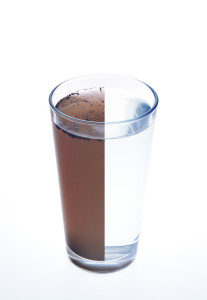If your high purity water system is starting to plug up, experience low flow, or shows high bacteria counts, it could be time to change or upgrade your filtration process. If that’s the case, you need to know how to pick the right filter for your application.
Choosing the correct water filter boils down to two factors: Filter pore size and filter type.
Dismiss either of these factors, and you’ll likely miss your required water quality mark.
Here are the steps that can lead you to the right filter for your application.
Step One: Determine Filter Pore Size
Selecting a filter with the correct pore size hinges upon your answers to the following three questions:
1. What are you filtering out? Are you trying to reduce the turbidity/particulate matter from your incoming water? Perhaps you need ultrapure water for a bacteria or endotoxin sensitive application.
2. What is the flow rate? How many gallons of filtered water do you require on average per day?
3. How fast would you like to flow the water? What is the incoming pipe size? Flow rates vary widely by filter, ranging from a quarter of a gallon per minute up to 1,000 gallons per minute.
Once you’ve answered these questions, a water treatment vendor can point you to a water filter with the appropriate pore size to meet your needs.
Types of Ultrapure water applications
Ultrapure water applications normally include a mixture of the following: The finest water filter available is a Reverse Osmosis (RO) filter, which measures one ten-thousandth of a micron in pore size.
The next step down is an ultrafilter, which is designed to remove bacteria and endotoxins.
After that comes a .05 sub-micron filter specialized for endotoxin removal. Finally, you have a .2 micron bacteria removal filter.
As an interesting side note, the design for the .05 micron filters are actually based on a human being.
Back in the 1950’s, a PHD studied how the liver/kidneys filter impurities out of the blood, and created a hollow fiber filter based on that concept.
Today, we still rely on this same design for endotoxin removal, often used in high purity water treatment systems. Using the body to help the body – pretty neat!
Step Two: Determine Filter Type
Considering pore size is critical, but not all filters are created equal. A filter’s rating tells you how much of a given particle size that filter can be expected to remove. Here are the two most common filter types:
1. Absolute rated
The rating of an absolute rated water filter is based on the largest sized particle that can get through the openings of the filter. In other words, it will remove absolutely everything equivalent or larger to the classified pore size.
For example, if you install a .2 micron bacteria removal filter, an absolute filter will remove everything that is .2 microns or larger.
An absolute rated filter may be twice the price of a nominally rated filter (which we’ll discuss below), but it’s worth it for anyone who uses a high purity water system. That includes:
- Applications that are bacteria sensitive
- Anyone with a validated system
- Applications that are endotoxin sensitive
- Systems that are inspected by the FDA
2. Nominal rated
The rating of a nominal rated water filter is based on the smallest sized particle that can get trapped in the filter. It will retain most of a particulate – normally between 60 and 80% – at the rated pore size.
A coffee filter provides a good example because it would trap many of the larger coffee grounds as well as some of the smaller grounds, though some smaller particles would still pass through.
If you don’t require ultrapure water, nominal rated filters are sufficient.
For instance, if you need a water filter to remove particles from drinking water, a nominal rated filter is a good option – and cheaper than an absolute rated filter.
Choosing a new water filter isn’t as easy as it sounds. Your water quality will suffer if you make an uninformed purchase.
Follow the steps we’ve laid out – and seek the guidance of a water treatment vendor – to find a water filter that will meet your unique needs.
We’ll do more than give you a quote—we’ll visit your site to analyze your industrial water needs.


Follow Us